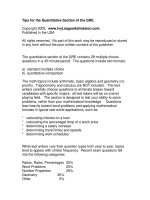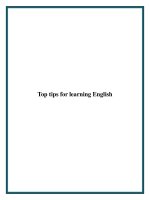Tips for MCQs
Bạn đang xem bản rút gọn của tài liệu. Xem và tải ngay bản đầy đủ của tài liệu tại đây (145.86 KB, 22 trang )
<span class='text_page_counter'>(1)</span><div class='page_container' data-page=1>
<b>I. AN OBJECTIVE TEST CAN HAVE A </b>
<b>I. AN OBJECTIVE TEST CAN HAVE A </b>
<b>VARIETY OF DIFFERENT TEST ITEMS LIKE:</b>
<b>VARIETY OF DIFFERENT TEST ITEMS LIKE:I. AN OBJECTIVE TEST CAN HAVE A I. AN OBJECTIVE TEST CAN HAVE A </b>
<b>VARIETY OF DIFFERENT TEST ITEMS LIKE:</b>
<b>VARIETY OF DIFFERENT TEST ITEMS LIKE:</b>
<b>1.</b>
<b>1.</b> <b><sub>Free – response</sub><sub>Free – </sub>response items<sub> items</sub></b>
<b>2.</b>
<b>2.</b> <b>True – false<sub>True – false</sub></b>
<b>3.</b>
<b>3.</b> <b>Fill in the blanksFill in the blanks</b>
<b>4.</b>
<b>4.</b> <b>Completion itemsCompletion items</b>
<b>5.</b>
<b>5.</b> <b>Match the itemsMatch the items</b>
<b>6.</b>
<b>6.</b> <b>Multiple – choice questions or MCQs, and Multiple – choice questions or MCQs, and </b>
<b>7.</b>
</div>
<span class='text_page_counter'>(2)</span><div class='page_container' data-page=2>
<b>II. Strategies for objective </b>
<b>tests taking.</b>
<b>A. Preparation for taking objective tests – </b>
<b>general suggestions.</b>
<b>1. Briefly look over the entire test to see what </b>
<b>is ahead of you.</b>
<b>2. Read the instructions for the whole test and </b>
<b>each subsection and make sure you </b>
</div>
<span class='text_page_counter'>(3)</span><div class='page_container' data-page=3>
<b>3. Note the number of items and figure out </b>
<b>how much time you have to answer each </b>
<b>one. For example, if there are 50 items</b>
<b>and your teacher limits the testing time </b>
<b>to 50 minutes, then you obviously have </b>
<b>only about a minute to answer each </b>
<b>question. The point here is that you </b>
</div>
<span class='text_page_counter'>(4)</span><div class='page_container' data-page=4>
<b>3.1. Answer the easy items first to get the </b>
<b>maximum number of points. This relieves </b>
<b>tension and gives you confidence, thus </b>
<b>loosening up material from your mind as </b>
<b>you proceed.</b>
<b>3.2.</b> <b>If a test is more than 1 hour in length, </b>
<b>give yourself 5 or so minutes to clear your </b>
<b>mind, stretch, and go to the restroom.</b>
<b>3.3. Check to see that your responses were </b>
<b>marked in the correct places on the </b>
</div>
<span class='text_page_counter'>(5)</span><div class='page_container' data-page=5>
<b>3.4. Are there penalties for guessing? If not, </b>
<b>answer every answer. </b>
<b>3.5. If you think you know an item but are not </b>
<b>sure, mark your response and come back to the </b>
<b>question. However, first impressions or </b>
<b>intuitions tend to be correct, so if you do </b>
<b>change your answer be sure you have a good </b>
<b>reason to do so; research indicates that in 3 </b>
<b>out of 4 times your first choice was probably </b>
<b>correct.</b>
<b>3.6. If the question seems intelligible, reword it </b>
<b>or break it down into part.</b>
</div>
<span class='text_page_counter'>(6)</span><div class='page_container' data-page=6>
<b>3.8. Don't waste time reviewing answers of </b>
<b>which you are confident are correct.</b>
<b>3.9. Beware of mandatory words such as </b>
<b>“never” or “must” or “always”. The obvious </b>
<b>answer might not be correct if there are </b>
<b>exceptions to the statements.</b>
<b>3.10. Words such as “seldom”, “normally”, </b>
<b>and generally” or ‘usually” allow </b>
<b>exceptions, however.</b>
<b>3.11. Use information from other test </b>
<b>items. Often the answer to a question is </b>
</div>
<span class='text_page_counter'>(7)</span><div class='page_container' data-page=7>
<b>B. Tips for types of objective </b>
<b>tests taking.</b>
<b>1. True – False questions:</b>
<b>1.1.</b>
<b> Watch for qualifiers or </b>
<b>mandatory words such as </b>
<b>"always," </b>
<b>never," or "must."</b>
<b> If they are </b>
<b>present, chances are the statement </b>
<b>is </b>
<b>"False,"</b>
<b> since few things are </b>
</div>
<span class='text_page_counter'>(8)</span><div class='page_container' data-page=8>
•
<b>Example:</b>
<b>(Comprehension Unit 7 – </b>
<b>English 12, 7 years)</b>
•
Question b (page 102):
<b>American </b>
<b>men </b>
<b>always</b>
<b> shake hands when they </b>
<b>meet. T / F</b>
•
The obvious answer here is false (F).
And questions c, f, h in this unit have
</div>
<span class='text_page_counter'>(9)</span><div class='page_container' data-page=9>
<b>1.2. If a question contains words such as </b>
<b>"seldom," "normally," or "generally", ect. </b>
<b>where an exception would not alter the </b>
<b>answer, chances are the answer is "True".</b>
• <b>Example: (Consolidation Unit 4 – English </b>
<b>10)</b>
• Question 4 (page 185): <b>Their language is </b>
<b>somewhat different from the Queen’s </b>
<b>English. T / F</b>
• <b>Even if you were not sure of your </b>
</div>
<span class='text_page_counter'>(10)</span><div class='page_container' data-page=10>
<b>1.3.</b>
<b>If a statement is more specific </b>
<b>than most, chances are it is </b>
<b>"True."</b>
•
Example
<b>: </b>
<b>(Unit 1 – English 12, 7 </b>
<b>years)</b>
•
Question d (page 10):
<b>English is </b>
<b>spoken as the first language in </b>
<b>many countries besides the </b>
</div>
<span class='text_page_counter'>(11)</span><div class='page_container' data-page=11>
<b>2. Multiple choice questions (MCQs)</b>
<b>* General rules for MCQs</b>
• <b>In multiple choice questions, anticipate </b>
<b>the correct answer before looking at the </b>
<b>options. </b>
• <b>Relate response options to the question </b>
<b>one at a time. And be sure to read all </b>
<b>of the options! Often people stop with </b>
<b>the first option that looks right. </b>
• <b>Balance options against each other. </b>
</div>
<span class='text_page_counter'>(12)</span><div class='page_container' data-page=12>
<b>2.1. Cues in the options</b>
<b>2.1.1. Most General options:</b>
•
<b>The correct option</b>
<b> is often </b>
<b>the most </b>
<b>general</b>
<b>, since the most general option </b>
<b>includes the most information. You </b>
<b>will often find a list of items that </b>
</div>
<span class='text_page_counter'>(13)</span><div class='page_container' data-page=13>
• Example: (Unit 2 – Reading skills, English 10)
• Question 4 (page 19): How did he obtain military
<b>secrets?</b>
<b>A. He passed the exams for the Civil Engineering </b>
<b> University.</b>
<b>B. He attended the University of Technology.</b>
<b>C. He quietly gathered bit by bit some thirty </b>
<b>thousand pages of documents on weapons.</b>
<b>D. None are correct.</b>
• <b>Even if you aren't sure of the correct answer, </b>
<b>you can see that the alternatives A, B, and D, all </b>
<b>deal with specific facts and details about some </b>
</div>
<span class='text_page_counter'>(14)</span><div class='page_container' data-page=14>
<b>2.1.2. Length:</b>
•
<b>The correct option is often the longest</b>
<b>. </b>
<b>If you have noticed that most of the </b>
<b>correct answers have been the </b>
<b>shortest, then when you aren't sure, </b>
<b>select the shortest. If, on the other </b>
<b>hand, most of the correct answers have </b>
<b>been the longest, select the longest </b>
<b>answer when you are unsure. No </b>
</div>
<span class='text_page_counter'>(15)</span><div class='page_container' data-page=15>
<b>2.1.2. Length:</b>
• For example: (Unit 2 – Reading skills, English 10)
• Question 4 (page 19): How did he obtain military
<b>secrets?</b>
<b>A. He passed the exams for the Civil Engineering </b>
<b>University.</b>
<b>B. He attended the University of Technology.</b>
<b>C. He quietly gathered bit by bit some thirty </b>
<b>thousand pages of documents on weapons.</b>
<b>D. None are correct.</b>
</div>
<span class='text_page_counter'>(16)</span><div class='page_container' data-page=16>
<b>2.1.3. Middle Value:</b>
•
<b>The correct option is usually of </b>
<b>middle value.</b>
<b> If the options range </b>
<b>in value - old to new, early to </b>
</div>
<span class='text_page_counter'>(17)</span><div class='page_container' data-page=17>
<b>2.1.3. Middle Value:</b>
• Example: <b>(Consolidation unit 3 – English </b>
<b>10)</b>
• Question 5 (page 127): <b>How much oxygen </b>
<b>does the Amazon forest produce in each </b>
<b>year?</b>
<b>A. 40% B. 14% </b> <b>C. 44%</b>
<b>D. None are correct</b>
</div>
<span class='text_page_counter'>(18)</span><div class='page_container' data-page=18>
<b>2.1.4. Two options Mean the Same:</b>
•
<b>The correct option is probably not </b>
<b>one of a pair of similar statements.</b>
<b>If two options mean the same thing, </b>
<b>and there is only one correct </b>
<b>answer, eliminate both of them. </b>
</div>
<span class='text_page_counter'>(19)</span><div class='page_container' data-page=19>
<b>2.1.4. Two options Mean the Same:</b>
• Example: <b>(Consolidation unit 3 – English 10)</b>
• Question 8 (page 129): <b>That foreigner </b>
<b>doesn’t have an entry visa. He entered the </b>
<b>country _____________.</b>
<b>A. illogically</b> <b>B. wrongly</b>
<b>C. incorrectly</b> <b>D. illegally</b>
• <b>Since options B and C have similar </b>
</div>
<span class='text_page_counter'>(20)</span><div class='page_container' data-page=20>
<b>2.1.5. Two options are Opposite:</b>
•
<b>The correct alternative is </b>
<b>probably one of a pair of direct </b>
<b>opposites.</b>
<b> If you notice that </b>
<b>two alternatives have opposite </b>
<b>meanings, one of them is </b>
</div>
<span class='text_page_counter'>(21)</span><div class='page_container' data-page=21>
<b>2.1.5. Two options are Opposite:</b>
• Example: (<b>Consolidation unit 3 – English 10)</b>
• Questions 6 (page 129): <b>Whale hunting </b>
<b>_____________ the whale species</b>.
<b>A.cancels </b> <b>B. kills </b>
<b>C. endangers </b> <b>D. maintains </b>
</div>
<span class='text_page_counter'>(22)</span><div class='page_container' data-page=22>
•
<i><sub>End of tips for </sub></i>
<i>objective test taking!</i>
•
Thank you for
</div>
<!--links-->









